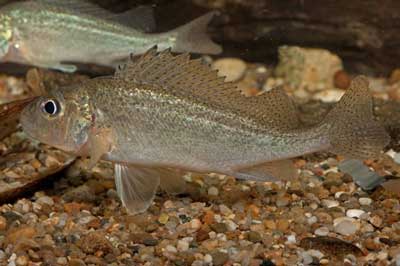Forschung
Sektion Ichthyologie
Forschungsprojekte der Sektion Ichthyologie

Traditioneller Fischfang am oberen Kongo bei Kisangani (Demokratische Republik Kongo) (Foto U. Schliewen)
Speciation and Phylogenetics
Organismic diversity is traditionally organized in populations, species and higher level systematic categories such as genera. We are interested in evolutionary patterns and processes that identify and generate species and genus level diversity. The main research focus is on the investigation of the effect of ancient and ongoing gene flow on the generation of species and genus level diversity, i.e. between populations, incipient or established species or even between taxa of different genera. Our main working hypotheses are that (1) species and species complexes of closely related species and genera represent phylogenetic networks rather than trees, and that (2) ancient and ongoing introgression as well as homoploid hybrid speciation have significantly contributed to the evolution of species level diversity and adaptive novelty.
To infer and analyze patterns of morphological, ecological and genetic diversity we use fish “species flocks” confined to comparatively small and well circumscribed areas, e.g. small lakes and well defined stretches of rivers. Study systems include or have included in the past assemblages of closely related fish species, i.e. cichlids (Perciformes: Cichlidae) of Cameroonian, Ghanaen and Nicaraguan crater lakes, cichlid species assemblages in the recently evolved rapids of the Lower Congo River, telmatherinid (Atheriniformes: Telmatherinidae) species flocks in tectonic lakes on the Indonesian island of Sulawesi as well as lantern sharks (Squaliformes: Etmopteridae). Recently, the evolving diversity of Ponto-Caspian gobies (Perciformes: Gobiidae) which invaded the upper (Bavarian) Danube has been added as an evolutionary fish model system at ZSM, as well as selected groups of Cyprinidae (Labeobarbus) and Rivulidae (Cynolebiasini).
Our methodological data acquisition and analysis tool-kit involves (1) traditional morphometric and anatomical measuring techniques, as well as geometric morphometrics based on digital images of photographed, digitally X-rayed (twodimensional or MicroCT), and (2) phylogenetic and population genetic analysis of DNA-sequence and DNA-fragment data including Next Generation Sequencing (NGS) approaches.
Currently financed projects include
Patterns and processes of a multiple cichlid diversification along a unique geographical gradient in the Lower Congo River: Are species complexes fluid genomic networks? (DFG-project SCHL567/4-3 in cooperation with co-applicant Prof. B. Misof, ZFMK Bonn, Prof. P. Alibert (Univ. Bourgogne, Dijon and Prof. Soleil Wamuini Lunkaliyakio (ISP-Mbanza Ngungu, DRC).
Abstract. Inter- and intraspecific gene flow is increasingly recognized as an important factor shaping diversification and speciation. We study the phylogeny, phylogeography and population genomics of four small cichlid species assemblages (Pisces: Cichlidae; 3-10 species each) endemic to the rapids of the Lower Congo River. The parallel evolution of five morphological and/or ecological divergent lineages/genera within a contiguous unidirectional topography of the Lower Congo River consisting of alternating rapids interconnected by slow-flowing areas allows testing parapatric and hybrid speciation hypotheses. Building on phylogeographic and morphometric results, we will take advantage of Next Generation Sequencing, stable isotope analysis and geometrical morphometrics to assess genome-phenotype-environment associations along an approx. 16 km stretch of the Lower Congo at Inga. This approach will give us the opportunity to compare the genomic architecture of all four cichlid groups and to assess the extent of homoploid hybrid origin of species.
Exploiting the Genomic Record of Living Biota to Reconstruct the Landscape Evolution of South Central Africa (VW-Stiftungs Project “Off the Beaten Track” in cooperation with co-applicants Dr. F. Cotterill and Prof. D. Bellstedt (Univ. Stellenbosch, South Africa), Dr. S. Niedermann (Deutsches GeoForschungsZentrum, Potsdam), and Prof. Auguste Chocha Manda (Univ. Lubumbashi, DRC) and Dr. E. Vreven (Africamuseum, Tervuren, Belgium).
Abstract. A concept study to refine and expand an entirely novel approach to reconstruct landscape evolution with unprecedented accuracy. On the one hand, this approach applies the resolution of next generation DNA sequencing of carefully selected fish groups informing phylogenies constrained by molecular clocks, which, on the other hand, are calibrated at an extremely fine detail with high precision rock dates of key landforms. Freshwater fishes are locked tightly into a landscape, which has tightly constrained their ecology and evolution. Their existence and thus distributions are entirely dependent on the prevailing drainage patterns, so their evolution over time has closely tracked even the slightest of wetland changes. Thus the theoretical foundations of this project integrate the phylogenetic signals of key fish groups with accurate rock dating to reconstruct landform evolution at fine-scale across a focal study area. Selected key landforms that we will date waterfalls and high plateaux must have shaped the phylogenetic history of multiple phylogenetically unrelated fish groups; we will thus use these dates to calibrate detected phylogenetic events in each of the four selected fish groups. By analyzing and synthesizing these data we will exploit the consilience resolution obtained across independent rivers and phylogenies to generate a history of landform evolution, which we propose will have far greater precision than conventional coarse-scaled methods of landscape evolution across across the African continent. As an important benefit for biological sciences the availability of large scale phylogenies resolved by precisely–calibrated nodes, will substantially deepen inferences about the palaeo-ecological constraints of biological processes which have shaped the evolution of biodiversity in these landscapes (e.g., the explosive evolution of the megadiversity in African Graben lakes), as well as the processes that shaped the Neogene landscapes of central Africa, where hominins evolved dependent on a wetland archipelago.
The study area is situated in northern Zambia and the south-eastern Katanga Province of Congo, comprising approximately 300 000 km2 of a tectonically dynamic landscape that is known for its high biotic diversity, in particular its fish fauna. The entire region has undergone major tectonically induced drainage changes. Thus, the modern northerly-flowing rivers are derived directly from precursors that originally formed a south-west drainage which sustained an archipelago of large endorheic palaeo-lakes across the Kalahari plateau. The wholesale changes to this regional drainage involved still partially understood river capture events, which redirected the Upper Congo drainages (Lualaba) and those of the Upper Zambezi and Kafue catchments. Key features of the landscape limiting the movement of fish taxa, i.e. faulting as evidenced by waterfalls and high plateaux will be dated by surface exposure dating with cosmogenic nuclides, and radiometric dating of the rocks and duricrusts respectively. The phylogenetic relationships of four major groups of fishes, previously studied in isolation, will be determined with high accuracy using RAD phylogenomic and mitogenome sequencing data. These include cichlids (haplotilapiine cichlids) belonging to a number of clades of which some seeded the famous species flocks of Africa’s Great Lakes, two genera of shellears (Kneria and Parakneria), an ancient fish family (Kneriidae), catfishes as represented by the torrent catfishes (Amphilius) and the toothed carps represented by the genus Nothobranchius. Collectively, these biotic indicators of landscape dynamics represent the entire river continuum from headwaters and floodplains to main channels, and this allows for a nested design of complementary sampling of all four groups along each river and across the different rivers in this study area. We will date generated phylogenies using the waterfall and plateau dates, and we will reconcile inferences about landscape and biotic evolutionary events dating back through the Quaternary and Neogene, and potentially into the Palaeogene.
Ecology and reproduction of Europe´s smallest fish species, the miniature gobies of the genera Lebetus and Speleogobius (Research grant from SeaLife Munich).
Abstract. With around 200 species in Europe gobies (Family Gobiidae) are one of the most diverse fish groups of the marine, brackish- and freshwater habitats of continent. Among those the so called sandgobies of the Pomatoschistus-lineage constitute an important model system for behavioural and marine ecology research, whereas two of their relatives are the smallest and one of the most colourful of all European fishes, i.e. the four members of the genera Lebetus and Speleogobius. Since extremely little is known about their ecology, and virtually nothing about reproductive behaviour and husbandry, we will undertake two short excursions to observe, photograph, videotape and collect life specimens for further aquarium observations and husbandry and public display optimisation of three of the four species: in the northern Adriatic (Croatia) and in southern Norway (Lysefjord): Lebetus guilleti (max. length 2.2 cm) and Speleogobius trigloides (max. length 2.5 cm), and Lebetus scorpioides (max. length 3.8 cm).
Recent publications include
Cerwenka, A. F., J. Brandner, J. Geist & U.K. Schliewen (2014). „Strong versus weak population genetic differentiation after a recent invasion of gobiid fishes (Neogobius melanostomus and Ponticola kessleri) in the upper Danube.“ Aquatic Invasions 9(1): 71-86.
Pfaender, J., R. K. Hadiaty, U.K. Schliewen & F. Herder (2016). „Rugged adaptive landscapes shape a complex, sympatric radiation.“ Proceedings of the RoyaI Society B Biological Sciences 283(20152342) DOI: 10.1098/rspb.2015.2342.
Schwarzer, J., A. Lamboj, K. Langen, B. Misof & U. Schliewen (2015) Phylogeny and age of chromidotilapiine cichlids (Teleostei: Cichlidae).“ Hydrobiologia 748(1 Advances in Cichlid Research: Behavior, Ecology and Evolutionary Biology): 185-199.
Weiss, J. D., F. P. D. Cotterill & U.K. (2015). „Lake Tanganyika – A ‚melting pot‘ of ancient and young cichlid lineages (Teleostei: Cichlidae)?“ PLoS ONE 10(4): e0125043.
Diversity, Systematics and Taxonomy

Der Ammersee-Kaulbarsch, Gymnocephalus ambriaelacus, eine von ZSM-Mitarbeitern aus Bayern neu beschriebene Fischart (Foto A. Hartl)
Based in a traditional natural history collection, our research approach is based on the intimate knowledge of the diversity, systematics and taxonomy of the organismic groups we study. This expert knowledge is mainly derived from the discovery, description and analysis of targeted field collections of morphological as well as individualized genetic voucher specimens. Field trips are performed to subsaharan Africa and within Europe, often in close cooperation with national and international GOs and NGOs, as well as with research partners in Germany, Europe or Africa. Either during biodiversity assessments of protected areas or in the framework of evolutionary biology research grants specimens are collected, which often contain scientifically undescribed species. Based on these collections as well as on intensive comparisons of globally distributed museum specimens, species descriptions, revisions as well as faunistic studies are being prepared either as part of the evolutionary biology studies (see above), or as standalone systematic studies. Currently, systematic work at the ZSM centers around cichlids (Cichlidae) and gobies (Gobiidae), but includes also studies on African non-cichlid freshwater fishes, marine gobies, as well as Bavarian freshwater fishes.
Recent publications include
Kovacic, M., F. Ordines & U.K. Schliewen (2016). „A new species of Speleogobius (Teleostei: Gobiidae) from the Western Mediterraenean Sea.“ Zootaxa 4066(3): 301-310.
Musilova, Z., A. Indermaur, A.R.B Nyom, R. Tropek, C. Martin & U.K. Schliewen (2014) Persistence of Stomatepia mongo, an endemic cichlid fish of the Barombi Mbo Crater Lake, southwestern Cameroon, with notes on its life history and behavior.“ Copeia 14(3): 556-560.
Schedel, F. D. B., J. P. Friel & U.K. Schliewen (2014). „Haplochromis vanheusdeni, a new haplochromine cichlid species from the Great Ruaha River drainage, Rufiji basin, Tanzania (Teleostei, Perciformes, Cichlidae).“ Spixiana 37(1): 135-149.
van der Zee, J. R., R. Sonnenberg & U. Schliewen (2013). „Description of three new species of Hylopanchax Poll & Lambert, 1965 from the central Congo Basin (Cyprinodontiformes: Poeciliidae: Procatopodini) with a redefinition of the genus.“ Zootaxa 3701(1): 035-053.
Vreven, E. J. W. M. N., T. Musschoot, J. Snoeks & U. Schliewen (2016). „The African hexaploid Torini (Cypriniformes: Cyprinidae): review of a tumultuous history.“ Zoological Journal of the Linnean Society 2016 DOI: 10.1111/zoj.12366


